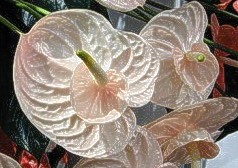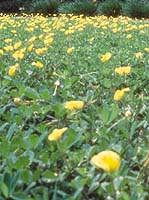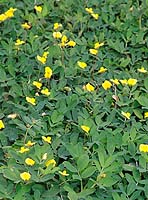Best of the Rest:
1. Perennial peanut groundcover
2. Search tool for garden plants
3. Using soap and detergent for pest control
4. Natural mosquito control

This occasional offering is for smaller items drawn (with permission
where appropriate) from other websites or from print, which may not have
got the notice that they deserve.
|
1. A drought tolerant groundcover for warm areas
Now that that's over, we can continue. Arachis glabrata is a relative of the common peanut, A. hypogaea, and has been studied for many years as a possible forage plant. Members of the University of Florida Agronomy Department were making selections when they noticed a few dwarf seedlings. E.C. French, associate professor of agronomy, knew that 6-inch varieties were no good for grazing livestock, but rather than throwing them out, he decided to look at their landscape potential. |
 |
|
|
This perennial peanut lawn in Gainesville, Fla.,
has remained maintenance-free, except for mowing, for six years.
|
||
Two selections have been made and tested and appear well suited as groundcovers. 'Arblick' and 'Ecoturf' both reach 6 inches high and produce yellow flowers from spring to fall. The two are easy to grow and require little or no maintenance once established. They are drought resistant and, being legumes, fix their own nitrogen. They have been established along roadsides where they receive no care other than mowing. French said plants can be maintained at 1 1/2 inches tall if mowed every two to four weeks. Mowing also stimulates flowering. "Flowers come on in April or May and really begin to crank up in summer," French said. "They'll continue to bloom through about September." Top growth dies back after frost, but the plant will come back as long as rhizomes, which can grow several feet deep, don't freeze.
Ornamental peanut can also be an annual groundcover in colder climates. Suitable to containers: Lake Brantley Plant Corp. in Longwood, Fla., produces ornamental peanut in 4-inch and 1-gallon containers. Four or five cuttings are stuck directly into gallon containers. Plants finish in eight to 10 weeks, said co-owner Paul Klinger Jr. Even though the plant is nitrogen-fixing, Klinger doesn't alter the fertilizer for ornamental peanut. He uses the same 15-9-12 liquid fertilizer he uses for the rest of his crops. The plant's best use is in low-maintenance areas, Klinger said. He has sold a good number of plants to municipalities for use on berms and embankments.
 |
SPECIFICS: Name: Arachis glabrata Common name: Ornamental peanut. Description: Spreading, easy-to-grow groundcover with yellow flowers. Without mowing, selected varieties get no higher than 6 inches and can be maintained at 1 1/2 inches by mowing every two to four weeks. Landscape uses: It is a good choice for hard-to-mow areas and landscapes that receive minimal maintenance. Full sun or partial shade is preferable. It is used as turf in Florida. Hardiness: Probably USDA Hardiness Zone 8. Aboveground growth dies back after freezes, but rhizomes will survive as long as the ground doesn't freeze. Propagation: Tip cuttings and root division. |
|
'Arblick' is a 6-inch cultivar developed by University
of Florida
|
. © 1999 Branch-Smith Publishing The editor wishes to thank the publisher
for permission to use this article. Many others of interest are at http://www.greenbeam.com
2. A valuable search tool for UK and other gardeners
The grand name of the Royal Horticultural Society should never have been off-putting to common-or-gardeners, and now more than ever the information and help which they offer is readily available.
A click of the mouse at http://www.rhs.org.uk/ will take you to a search engine that can handle the most intricate requirements of a site in your garden and come up with suggestions of suitable plants. This is available to members and nonmembers alike, but, of course, there are many benefits that are restricted to those who fork up (sorry!) the membership fee. Even for overseas members there is the superb monthly magazine, plus the inducement of free entry to the society's gardens and reduced prices for shows that add another reason for a vacation in England (as though extra reasons were really necessary). It is worth cruising the site anyway, and for UK residents there is the other extremely useful search possibility of the plant finder to see who is growing what.
3. "Soaps" and detergents: Should they be used in Interior Plantscapes?
Insecticidal soaps are used to control a variety of insects and mite pests, including aphids, scales, mealybugs and two-spotted spidermites. A soap is a substance derived from the activity of an alkali such as sodium hydroxide (hard soap) or potassium hydroxide (soft soap) on a fat. Fats are generally a blend of particular fatty acid chain lengths.
Soaps generally have minimal activity on beetles and other hard-bodied insects, although they have been used to kill cockroaches. In any case, they are effective only when the pest comes into direct contact with the spray. Dried residues have little activity.
There are three ways that soaps may kill insect and mite pests. First, soaps may work by penetrating through the insect's outer covering (cuticle) and disrupting cell membranes resulting in cell leakage and dehydration and death of the insect. Second, they may act as insect growth regulators, and third, they may block the breathing pores (spiracles) interfering with respiration.
Although only a few types of soap have insecticidal properties, several common household types have had some effect when used at a 1 to 2% rate in water as a spray. Examples are:
1. Palmolive®, Dawn®, Joy,® Ivory® and Dove® reduced the numbers of whitefly, aphids and spidermites on a variety of vegetable crops.
2. Dawn Ultra® dishwashing liquid gave 100% mortality on German cockroaches (Blattella germanica)
3. Ivory® liquid dishwashing soap and Tide® detergent were effective in reducing populations of aphids, citrus red mite, psyllids and greenhouse thrips on landscape plants
A number of other similar successes have been obtained in controlled tests. In spite of this, dishwashing liquids and laundry detergents are designed to dissolve grease from dishes and to clean clothes, not to kill insects, and may cause plant injury by dissolving the waxy protective surface (cuticle) of the plants.
It is important to note that these are not registered pesticides, and commercial use may not be legal. For this reason there use cannot be recommended, particularly since there are good insecticidal soap products on the market. The makers of these would stand behind their product in the event of damage, whereas the dish or laundry soap would not have this guarantee on which to fall back.
This article is extracted from an article by Dr Raymond Cloyd of the National Soybean Laboratory that appeared in the OFA Bulletin (phone 604 487-1117) July-August 2003, Number 879. The Ohio Florists Association holds the copyright and grants permission for the use here.
4. Natural mosquito control
At a time when the number of West Nile virus cases is setting new records, University of Florida researchers are developing an environmentally friendly way of controlling mosquitoes without pesticides. The solution: a rugged little crustacean that wages war on mosquito larvae with an almost maniacal vengeance. "We're using a native organism to control mosquitoes when they breed in standing water, usually in ponds, tires and other open containers," said Jorge Rey, a professor of entomology with the University of Florida's Institute of Food and Agricultural Sciences. "By adding tiny crustaceans called copepods to the water, we can kill mosquito larvae before they become adults that may spread West Nile and other diseases," he said. "Tests at our Florida Medical Entomology Laboratory in Vero Beach show that the copepods feed on mosquito larvae at an amazing rate, killing up to 90 percent of the larvae." Rey said the copepod species he is testing, Macrocyclops albidus, is very aggressive toward its prey. In fact, the copepods will kill the mosquito larvae even when they are not looking for a meal. . "We don't know why they behave this way -- it might be a reflex action or they’re just being mean."
Rey, who has been testing the copepods for almost two years in discarded tires and other containers, said they can survive year-round in any size body of fresh water. His research shows the copepods prefer young mosquito larvae, usually those not older than four days. But they will attack older larvae when the number of young larvae declines. He said the copepod is native to Florida and common throughout the world. It poses no danger to people, animals or plants. However, they don't exist in every body of water and therefore would have to be introduced in order to be effective on a wide scale. "Once the copepods become established, they reproduce in high numbers for effective natural or biocontrol of mosquito larvae," "Copepods survive so well because they feed on a wide range of insect prey in the natural environment."
An instruction sheet for growing copepods is should be available from
UF very soon. Rey said biocontrol techniques, such as using copepods for
controlling mosquito larvae, are attractive for developing countries where
human resources usually are more available than money for expensive control
alternatives.
More information on this topic is available at http://extlab7.entnem.ufl.edu/PestAlert/arbovirus/crustaceans.htm
Back to Table of Contents